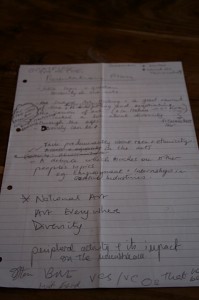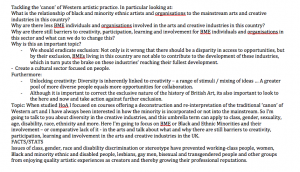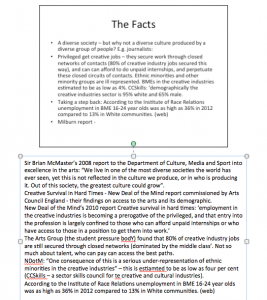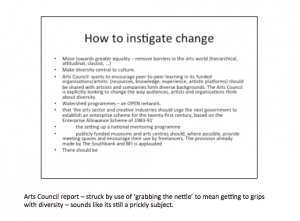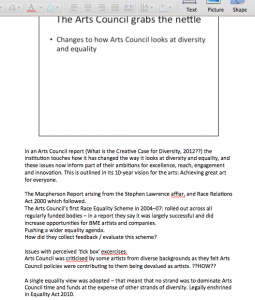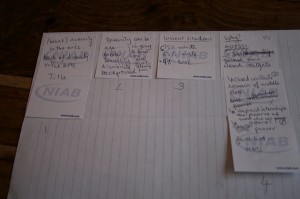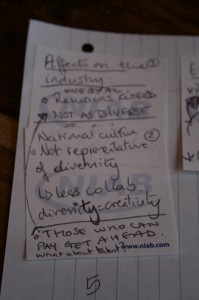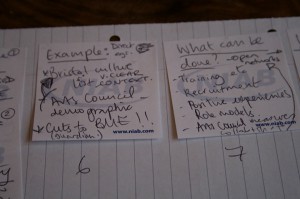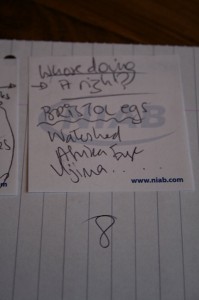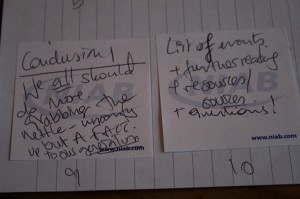Initial Idea, Planning + Research
I decided to talk about the issues surrounding diversity in the arts in my presentation this week. I wanted to specifically talk about diversity in terms of ethnicity, specifically the under representation of Black and Minority Ethnicity or BME people in the arts and creative industries. I was keen to find out more about why there are still barriers to creativity and participation for BME individuals and organisations in the art world. I intended to look at how we can challenge and eventually change this.
I reflected on my own experiences of the arts and culture industry and gathered other individuals’ thoughts. I also found out statistics (for the UK, Bristol & the South West) and further information using government and research institute websites, read reports by the Arts Council and other organisations, as well as news articles and websites. At the end of the powerpoint which I made for the presentation, there is a list of sources and some suggested further reading which deals more broadly with the issue of diversity in the arts.
Here are some photos of my research and planning along with some screenshots of a powerpoint presentation which I used to collect my thoughts, evidence and sources in.
Outline of my case
I used a quote from Sir Brian McMaster’s 2008 report to the Department of Culture, Media and Sport into excellence in the arts to act as a springboard for my argument. He says:
We live in one of the most diverse societies the world has ever seen, yet this is not reflected in the culture we produce, or in who is producing it.
I found this statement particularly interesting as I believe that the crux of this argument rests on under-representation of BME communities in the arts and creative industries. I wanted to point out that I felt that a lack of diversity in the cultural sector meant a stifling of creativity and a ‘national culture’ (is there such a thing?!) that is not fully formed – at least not fully representative.
I believed this was due to access to opportunities, networks and jobs, and my research supported this. I do not think it is a case of mindful discrimination according to where you or your relations come from in the world, but rather the demographic of people involved (creating and consuming) in the arts is fairly homogeneous and the industry itself is not that flexible, despite it growing fast.
The routes into the arts are still mainly traversable only if you can do unpaid internships or have family connections in organisations and the like. There will always be competition between candidates, and that is a good thing as it keeps standards high, but if you do not have the same level of access to the competition, then something isn’t right.
I wanted to give a snap shot of the industry of recent, illustrate some of the challenges and barriers to BME communities in the arts and also highlight some ironic facts and figures that I found in order to interrogate the way we like to talk about BME participation in the arts. I also wanted to give the positive side of things – who was doing what, and how, and why – it isn’t all doom and gloom!
Most importantly, I wanted to open up a debate on something which I think is often hushed up because it seems like the UK has moved on from the days of the 70s, 80s and even 90s when overt or casual racism and discrimination towards BME communities was not considered absolutely politically incorrect. Just because we have learnt to talk about something, does not mean we are talking about it or engaging with it. I wanted to see what the others in the group thought about these ideas and opinions. I wanted us to “grab the nettle” together… (I cannot explain how weird I think that phrase really is…!!)
Here is the video of my presentation.
Here is a copy of the presentation and notes I had on the day.
Reflections on the Q&A session
It was great that everyone had so much to say. I argued that a dialogue needed to be opened up and it certainly was. I was happy that the group wanted to talk about diversity, and offered up their own ideas, opinions and experiences.
Varun raised some very interesting points – ones that I would have loved to cover in the presentation but just didn’t have time. He talked about access and the socio-economic factor (which is perhaps the biggest and something I want to find out more about in detail) impeding some BME communities to follow creative paths which often call for unpaid internships or voluntary work. It is true that this is not just linked to ethnicity in the UK but mainly class – which is essentially the barrier to a lot of people’s involvement in the arts industries and THIS is the bigger issue (but one for another day perhaps)…
Varun also commented on the idea of expectations on BME creatives – that people expect you to be a certain way or have certain concerns or want to work in a certain way. I agreed that this is in itself a discrimination and is not acceptable. When he also raised the issue of ‘guiding’ people from BME backgrounds or any background really in their creative work, he also touched on an interesting part of this debate. There is a real tension between wanting to give BME artists and their work a platform and also being prescriptive or patronising.
Tensions spilled out all over the place during the presentation – like when Flo asked about the audiences BME events are aimed at/attract. It makes we ask questions like… What is their purpose? Is it to raise the profile of a community? Is it to open a dialogue between different members of different communities? What about the minorities of BME communities – who is representing their story? Is it about making BME work part of the mainstream? How can arts and issues around BME communities and their histories and their place in the UK today be produced, programmed, talked about and recorded? Whose responsibility is it to make sure all people have equal access to jobs in the arts? How can we realistically remove socio-economic barriers and other barriers to opportunities in the arts to show all people of all backgrounds and walks of life that they can be involved in the arts as well and that it is POSSIBLE?
In short, I loved that we could talk about this in the context of this course and the debate has left me with just as many questions as before.
Researching and talking about the issue has made me want to find out the answers to my questions even more than before. I intend to continue to talk to arts practitioners about, read articles and blogs on the topic, as well as listening to seminars about this very issue that are available online. I also want to research and talk to project leaders in this area and see what they have to say about their specific work and experiences.
I feel like my presentation just opened up lots of questions and a lot of tensions, but hopefully, not just for me, for the others in the group as well.
Further reflection
12 Years A Slave has opened at Watershed and we have opened the debate to the public and are attempting to engage audiences other than our core audience. Claire Stewart sent around this very interesting open letter in relation to a sold-out screening of the film at The Walker Art Centre.
It is incredibly interesting and talks about the dangers of placing BME work in a vacuum where the audience watching is not representative of the culture on show. I agree with many of the points raised in this letter as well. It’s not just that we should not make assumptions that only BME communities will want to engage with BME events and not others, or that BME events are just for BME communities. It is also important to recognise that without a representative audience in any situation, the work on show can become valued as ‘exceptional’ or its true cultural value is not unlocked, when it is placed in a ‘dialogue’ where the voices of members from that community are not heard.
